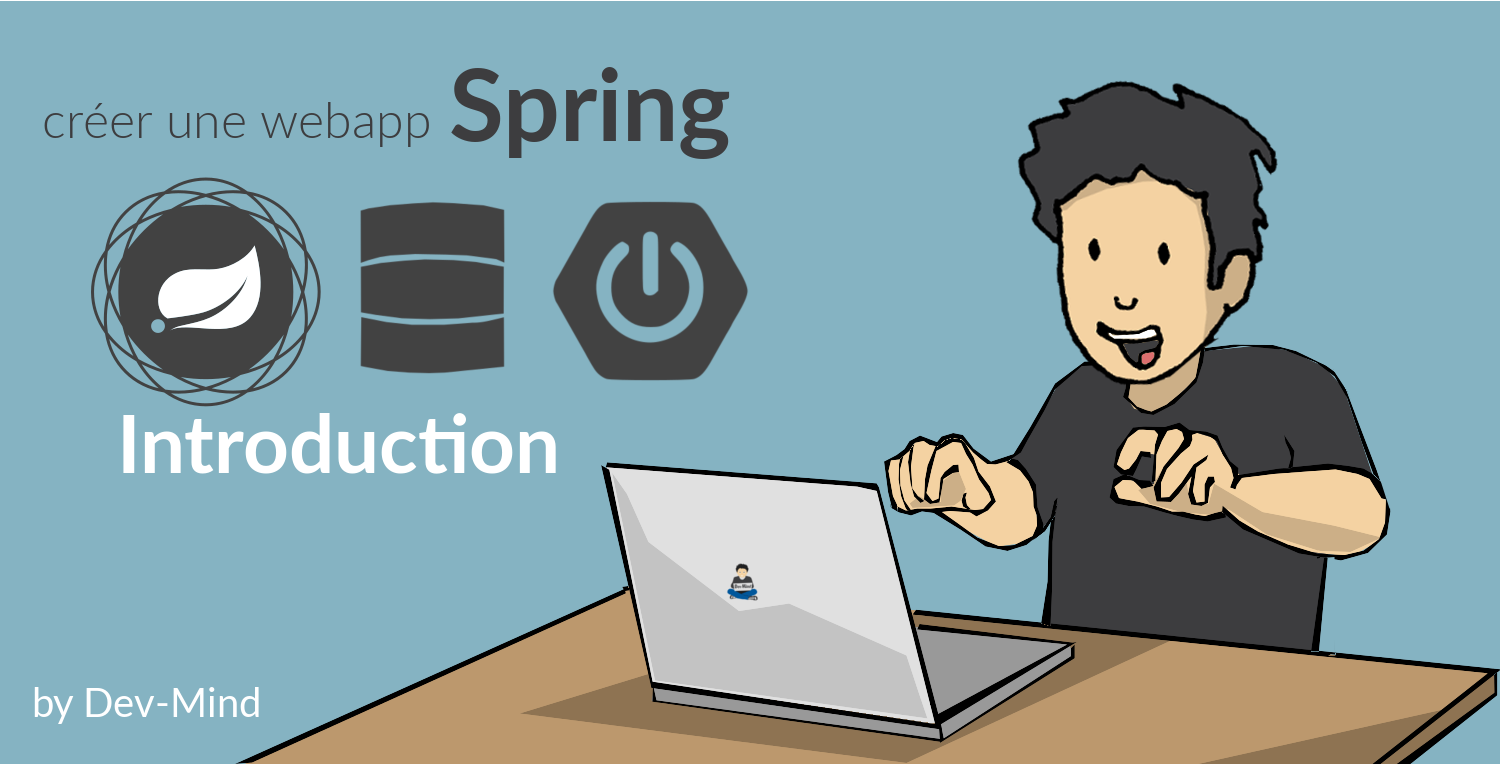
Since the beginning, Spring has been a set of tools designed to simplify the development of Java applications for every developer. Spring’s focus on speed, simplicity, and productivity has made it the world’s most popular Java framework.
The last versions of Spring supports other languages on the JVM like Kotlin. But we will focus on Java in this lecture course.

Introduction
Requirements
To be able to learn Spring you must have
-
some basics in Java and JEE. If you need to follow a complete course you can see the fabulous work of Jose Paumard and watch his video to learn Java.
-
know unit testing in Java. If not you have a course on this web site.
-
have knowledge of the Web mechanisms
-
know about JDBC and Hibernate. We will see the main principles of these libraries during this course.
-
a PC with a good IDE as IntelliJ. Follow this page to install your dev environment (IDE + Java)
What’s Spring ?
Spring is the most used Java framework. A framework comes with rules to organize developments
-
Good practices
-
Abstraction of the complexity
-
Provides utility classes
-
Helps to focus on the business code and not on the technical plumbing
Spring is
-
an Open Source Java framework. You can see the code and contribute to the project
-
an entire ecosystem. Spring provide a lot of tool to develop your app, deploy your app, manage your app
-
a company (Spring is open source Licence «Apache 2.0» but managed by a company Broadcom)
Spring framework
Spring projects were created to facilitate Java development
-
Spring Core provides a framework to simplify project technical aspects
-
Sub-projects deal with more specific technical issues (Data, Security, Cloud…)
-
Nothing is mandatory, everything is configurable
-
Big effort on backward compatibility to be able to always upgrade your project to the last versions.
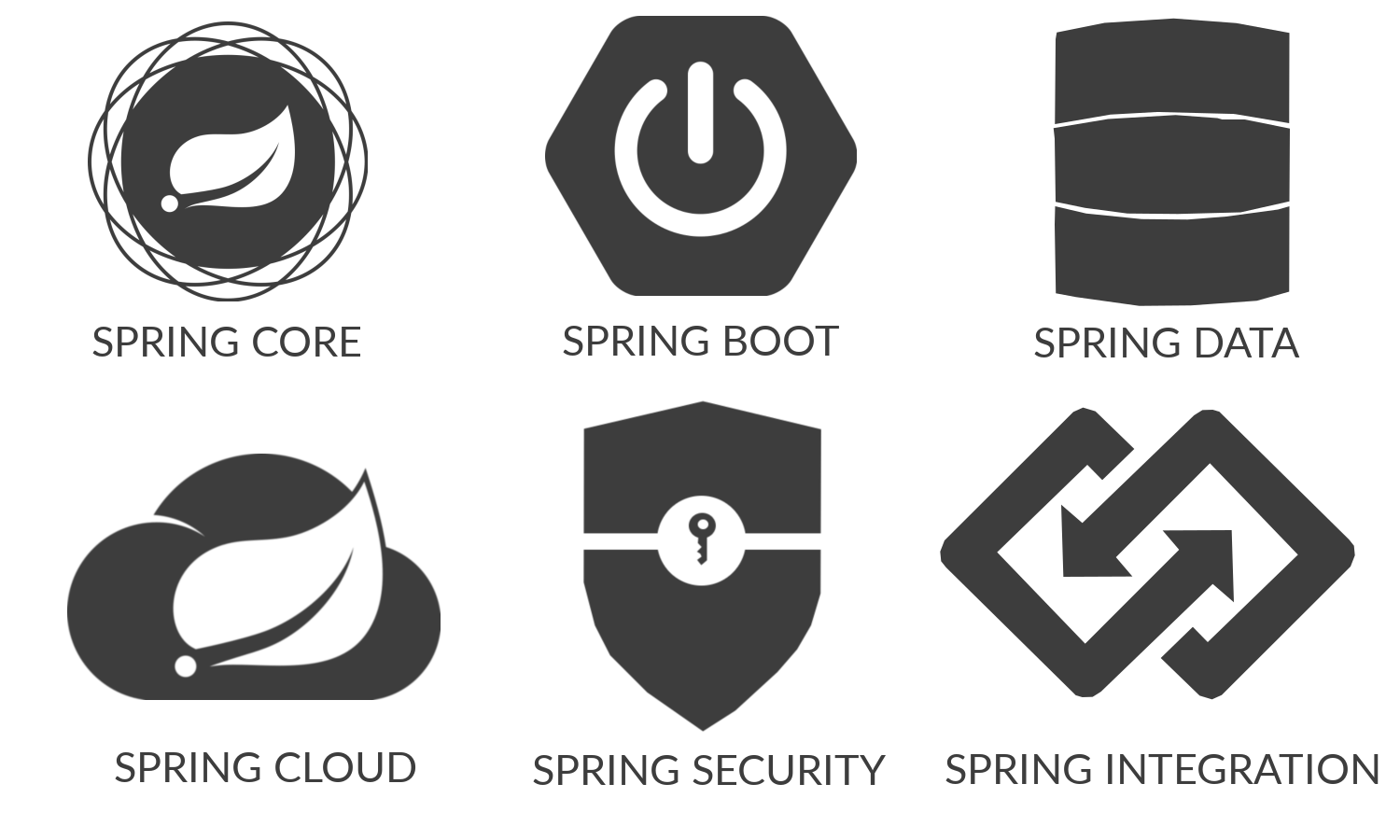
Documentation
You can read the documentation related to everything we will see together during these lessons
-
Spring Core https://docs.spring.io/spring/docs/current/spring-framework-reference/
-
Spring Boot https://docs.spring.io/spring-boot/docs/current/reference/htmlsingle
-
Spring Data JPA https://docs.spring.io/spring-data/jpa/docs/current/reference/html/
-
Spring Security https://docs.spring.io/spring-security/site/docs/current/reference/htmlsingle/
Spring Boot
Spring Boot helps you to create stand-alone, production-grade Spring applications.
The goal is to start an application in 3 lines. To do that, Spring Boot takes an opinionated view of the Spring platform and third-party libraries. A default convention is applied out of the box, but you can deviate easily from the defaults if you need to.
Spring Boot provides a range of non-functional features that are common to large classes of projects (such as embedded servers, security, metrics, health checks, and externalized configuration).
Spring boot starters
Starters are a set of convenient dependency descriptors that you can include in your application.
-
spring-boot-starter-web : Starter for building web, including RESTful, applications using Spring MVC. Uses Tomcat as the default embedded container
-
spring-boot-starter-data-jpa : Starter to configure Hibernate and a datasource to store your data in a DBMS.
-
spring-boot-starter-test : Starter for testing Spring Boot applications with libraries including JUnit, AssertJ and Mockito
-
…
Spring Boot autoconfiguration
Spring Boot attempts to automatically configure your Spring application based on the jar dependencies that you have added. For example, if you have a database driver in your classpath, you don’t have to configure any database, the Spring Boot auto-configuration do the job for you. You juste have to configure some properties to customize the datasource username, password and Url.
 Start a new project
Start a new project
Generate
To start a new project, you can (you should) use the official generator https://start.spring.io/

Use these settings
-
Project : Gradle Kotlin
-
Project metadata:
-
group :
com.emse.spring -
Spring version:
3.3.2 -
artifact & name :
automacorp -
Packaging :
jar -
Java :
21
-
-
Dependencies, click on button "ADD DEPENDENCIES"" to choose which sub projects we will use. Choose Spring Web
Click on the Generate button (bottom of the screen) to download a zip with generated files.
Import zip in your IDE
-
Unzip the project into a directory (you can put it next to the first project we did in the TPs)
-
Open the project in IntelliJ Idea. This step may take a long time if your Internet connectivity is slow. IntelliJ will update Gradle and all dependencies needed by the project.
-
You should have this project structure. One Application is generated with tests
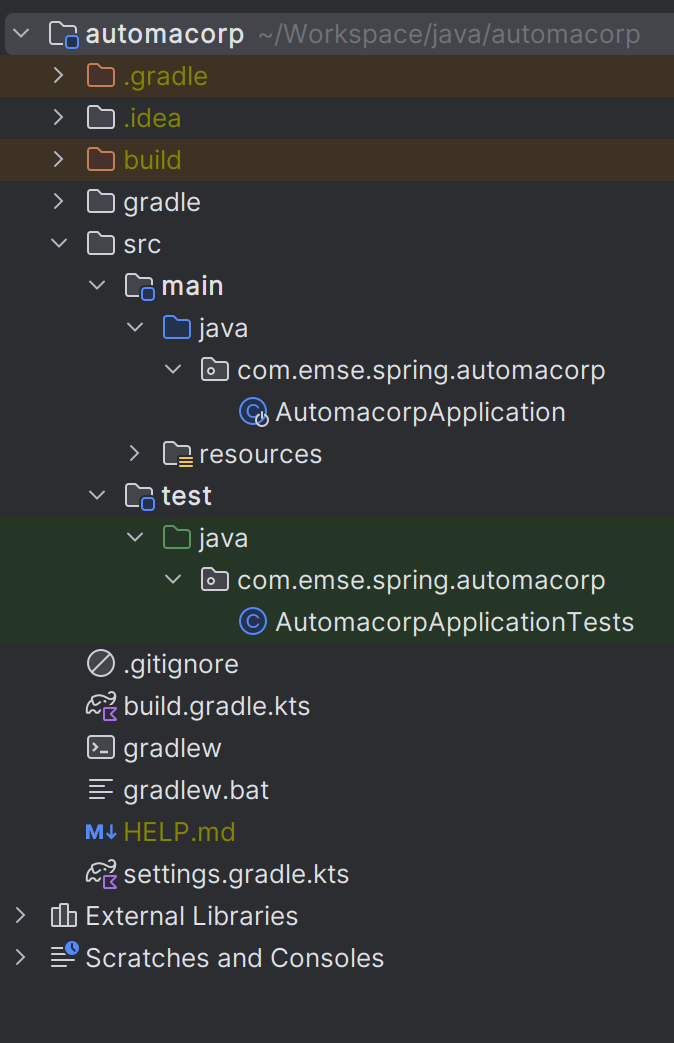
We will open the main generated files
Read Gradle configuration
File : > settings.gradle.kts contains the project name
rootProject.name = "automacorp"File : > build.gradle.kts contains information used by Gradle to build app
plugins {
java // (1)
id("org.springframework.boot") version "3.3.2" // (2)
id("io.spring.dependency-management") version "1.1.6" // (3)
}
group = "com.emse.spring" // (4)
version = "0.0.1-SNAPSHOT"
repositories { // (5)
mavenCentral()
}
java { // (6)
toolchain {
languageVersion = JavaLanguageVersion.of(21)
}
}
dependencies { // (7)
implementation("org.springframework.boot:spring-boot-starter-web") // (8)
testImplementation("org.springframework.boot:spring-boot-starter-test") // (9)
testRuntimeOnly("org.junit.platform:junit-platform-launcher") // (10)
}
tasks.withType<Test> { // (11)
useJUnitPlatform()
}-
(1) Adds the Java plugin to help Gradle to manage our Java app lifecycle
-
(2) Adds the Spring Boot plugin to be able to add task to run, compile, assemble our Spring Boot app
-
(3) Adds Spring dependency management plugin to use the compatible dependencies with the Spring Boot version
-
(4) Project id and versions
-
(5) Tell Gradle where it will find all libraries
-
(6) Customize the Java plugin and define the default Java version used by the project
-
(7) This block contains all dependencies used by our app.
-
(8) spring-boot-starter-web to load all the elements to start a web app (embedded server, libs to write REST services…)
-
(9) spring-boot-starter-test contains all lib used in tests (Junit, Mockito, Assetj…)
-
(10) configure junit runner to test execution
-
(11) declare the Junit 5 runner to use to execute the tests
App files
File : > src > main > java > com.emse.spring.automacorp.AutomacorpApplication
The annotation @SpringBootApplication initialize a Spring Boot application. This is your app entry point
package com.emse.spring.automacorp;
import org.springframework.boot.SpringApplication;
import org.springframework.boot.autoconfigure.SpringBootApplication;
@SpringBootApplication
public class AutomacorpApplication {
public static void main(String[] args) {
SpringApplication.run(AutomacorpApplication.class, args);
}
}On startup Spring Boot will automatically scan all sub packages, defined below com.emse.spring.automacorp.
If these packages contain classes annotated with special annotations like @Controller, @Service, Spring Boot will automatically add them to the Spring context. This classes will be called Spring Beans. We will see more in the next chapter.
File : > src > main > java > com.emse.spring.automacorp.AutomacorpApplicationTests
This class is the test file of your AutomacorpApplication. In a good application, all files are tested and verified by unit tests
@SpringBootTest // (2)
public class AutomacorpApplicationTests {
@Test
public void contextLoads() { // (3)
}
}-
(1) Runner to use when we want to test a Spring class. This Junit runner is a class that extends the Junit Runner to add more feature when your test is launched. x
-
(2) Annotation which creates an application context dedicated for tests. Spring Boot provide several annotations to facilitate tests.
@SpringBootTestwill launch a complete context and help to test a class in a real context. To be more efficient you can load only some part of the context.@DataJpaTestwill only load the database objects and the class to test…. -
(3) In a Junit test you always have to write a test method. This method will be executed when you launch the test. Even if the content is empty, in this example Spring will try to launch all the context. If somethings is wrong you will have an error
You can run this test if you click on green button
File : > src > main > resources > application.properties
It contains all the application properties. For the moment this file is empty
-
A property has a key and a value.
-
In your code you read a property by its key and Spring will load the value at runtime
-
Properties help to customize app on a particular environment+
 Launch application
Launch application
With Gradle
./gradlew --continuous bootRun // (1)
[...]
2023-08-22T17:15:59.685+02:00 INFO 124158 --- [ restartedMain] o.s.b.w.embedded.tomcat.TomcatWebServer : Tomcat started on port(s): 8080 (http) with context path ''
2023-08-22T17:15:59.697+02:00 INFO 124158 --- [ restartedMain] c.e.spring.automacorp.AutomacorpApplication : Started AutomacorpApplication in 1.76 seconds (process running for 2.126)
2023-08-22T17:16:04.331+02:00 INFO 124158 --- [nio-8085-exec-1] o.a.c.c.C.[Tomcat].[localhost].[/] : Initializing Spring DispatcherServlet 'dispatcherServlet'
2023-08-22T17:16:04.332+02:00 INFO 124158 --- [nio-8085-exec-1] o.s.web.servlet.DispatcherServlet : Initializing Servlet 'dispatcherServlet'
2023-08-22T17:16:04.334+02:00 INFO 124158 --- [nio-8085-exec-1] o.s.web.servlet.DispatcherServlet : Completed initialization in 2 ms
<==========---> 80% EXECUTING
> :bootRun // (2)</==========--->-
(1) the --continuous gradle option will restart the server when we recompile the project
-
(2) the build gets "stuck" at XX%, but the server is actually started and ready to accept connections. To stop the application use kbd: [Ctrl + c]
A this step you can open URL localhost:8080 in your favorite browser. You should see this page
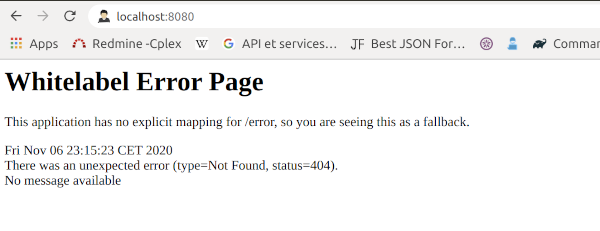
If Spring can’t start your app you must read the logs in your terminal. For example il port 8080 is already used you will have this error
***************************
APPLICATION FAILED TO START
***************************
Description:
Web server failed to start. Port 8080 was already in use.
Action:
Identify and stop the process that's listening on port 8080 or configure this application to listen on another port.If you need to use another port you can. For that open the file application.properties and add a new entry
server.port=8085You can relaunch the app. To stop the running app use Use [Ctrl + c] to stop the application.
Application packaging
With Spring Boot, your application is packaged in a jar file containing an embedded application server to run your code. You have only one jar and all dependencies are inside
./gradlew assemble-
This task generate a jar (Java archive) in
build/libs. -
jar name is
automacorp-0.0.1-SNAPSHOT.jar. The version is defined in your Gradle configuration. It contains everything you need to launch the application (conf + libs)
To launch your Spring Boot App you can execute
java -jar build/libs/automacorp-0.0.1-SNAPSHOT.jarYou can stop your app [Ctrl + c]
Launch application in dev mode
com.emse.spring.automacorp.AutomacorpApplication is a bootable class because it contains a main class
public static void main(String[] args) { }Open this class. You can click on the green button in the margin
or use launch configuration in your toolbar 
When app is started, Run pannel is opened on the bottom. This pannel contains logs (if you search informations on errors). The button stop (red square) can be used to stop app
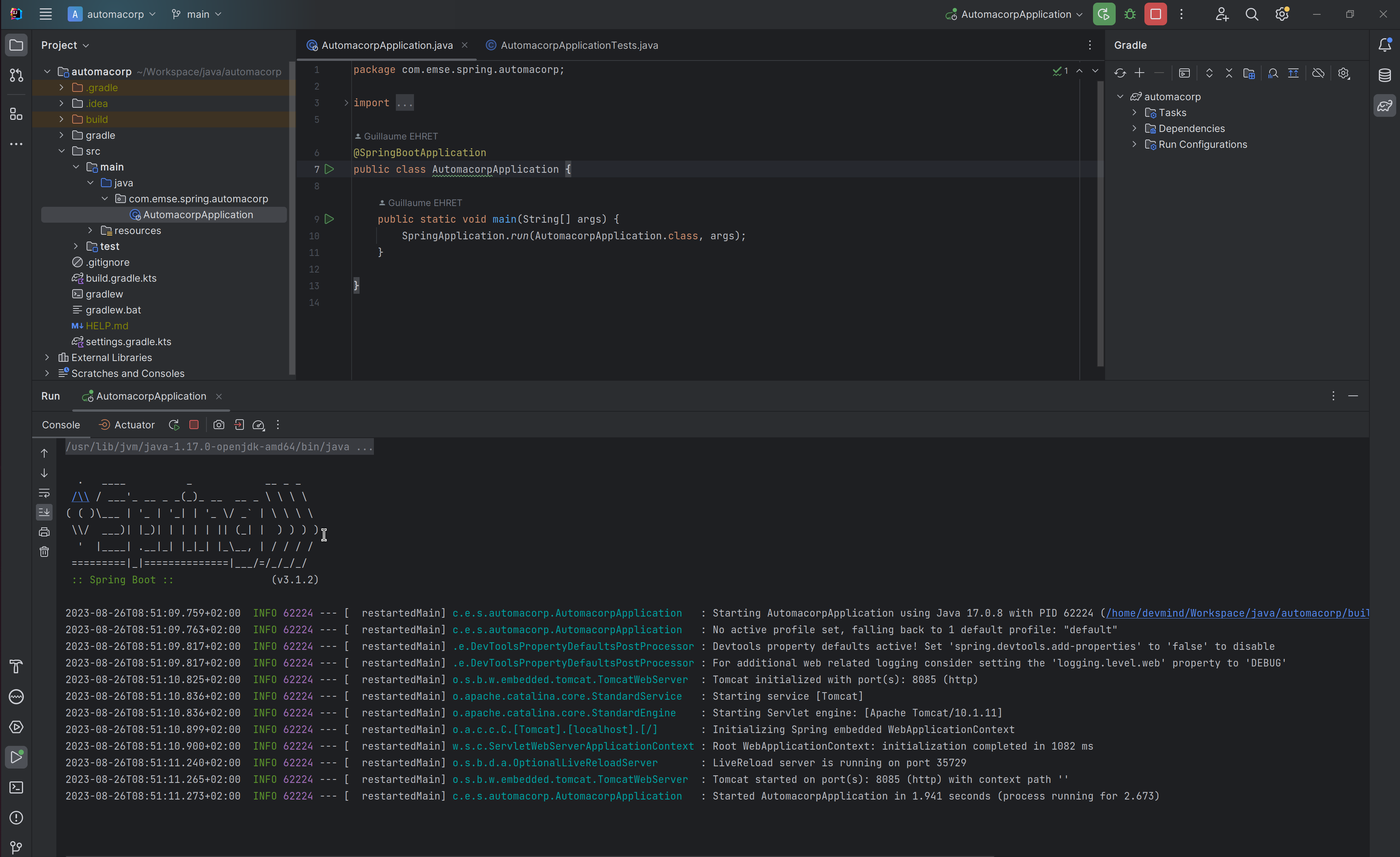
This third solution to launch the application is the one recommended when you develop your application
 Update the welcome page of your app
Update the welcome page of your app
-
Create a new file in
src/main/resources/static. The name will beindex.html -
In this file copy the following code
<html> <head> <title> Spring in practice</title> </head> <body> Hello world </body> </html> -
Recompile your code or restart your app
-
Reopen http://localhost:8080 in your browser. You should see your Hello message
If you want to have a nicer page, you can include a CSS library as Bootstrap (see the CDN links)
You can copy this line in the header of your HTML page.
<link href="https://cdn.jsdelivr.net/npm/bootstrap@5.3.3/dist/css/bootstrap.min.css" rel="stylesheet" integrity="sha384-QWTKZyjpPEjISv5WaRU9OFeRpok6YctnYmDr5pNlyT2bRjXh0JMhjY6hW+ALEwIH" crossorigin="anonymous">After this import you can use the different CSS components provided by Bootstrap. To see the result update your page
<body>
<div class="container">
<h1>Automacorp</h1>
<p class="lead">
Welcome on the Automacorp App used to learn Spring.
</p>
</div>
</body>Understand what’s happened
In few lines you have started your first Spring project. I spoke about Spring, Spring Framework, Spring Boot… But what’s the difference ?
Spring Framework
Spring Framework is a popular, open-source, Java-based application framework. You have the core library but you have a lot of another ones when you want to add more features in your application : data storage, web, security, ….!
When you add a new Spring or non Spring library, you need to configure your application (configuration beans, properties…)
You can have to do a lot of thing. That’s why we prefer use Spring Boot.
Spring Boot
Spring Boot takes an opinionated view of the Spring platform and third-party libraries.
With Spring Boot, it’s easy to create applications for all types of workloads. Most Spring Boot applications need very little Spring configuration.
Spring Boot is a "convention over configuration" type of framework, with no code generation.
When we use Spring MVC (the original web framework built on the Servlet API), we need to configure for example the dispatcher servlet among other things. When we use the Spring support of Hibernate/JPA, we would need to configure a datasource, an entity manager factory, a transaction manage….
Spring Boot simplifies all of these configuration elements, by auto-configuration. For example, when it sees spring-webmvc on the classpath, Spring Boot adds automatically @EnableWebMvc on your context.
With Spring boot we will use starters
dependencies {
implementation('org.springframework.boot:spring-boot-starter-web')
testImplementation('org.springframework.boot:spring-boot-starter-test')
}The starter name starts by spring-boot-starter-XXXX and use a suffix XXXX (web, cache, data-jpa, mustache, web…)
In the next course we will see how to add objects to our app and how we can linked them each other…